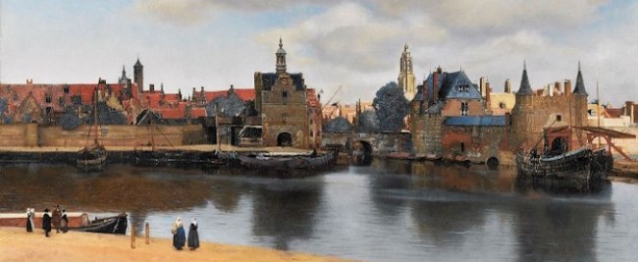
“View of Delft,” by Johannes Vermeer. (Mauritshuit)
Early in Girl With a Pearl Earring, Tracy Duvalier’s novel set in 17th century Holland, is a passage that launched several thoughts about architecture and design. The teenage girl has just become a maid in the household of the successful painter Johannes Vermeer. She is allowed on Sundays to visit the home of her mother and father – he was a maker of Delft tiles until a recent accident blinded him. She describes her first visit home:

“Girl With the Pearl Earring,” by Johannes Vermeer. (Mauritshuis)
When we ate dinner I tried not to compare it with that in the house at Papists’ Corner, but already I had become accustomed to meat and good rye bread. Although my mother was a better cook than [Vermeer’s cook] Tanneke, the brown bread was dry, the vegetable stew tasteless with no fat to flavor it. The room, too, was different no marble tiles, no thick silk curtains, no tooled leather chairs. Everything was simple and clean, without ornamentation. I loved it because I knew it, but I was aware now of its dullness.
The description suggests, with delicacy, how embellishment – of cuisine, of decor, of architecture – brings a more or less subtle richness to life. Maybe those without such embellishment get the greatest pleasure from it, if and when they can experience it. Maybe it is possible to love “dullness” only through deprivation of embellishment. If so, then maybe we need more traditional houses on public streets. serving (as I noted in “Beauty as a social good“) as free art museums for the general public, including those of low income, who need only stroll by to enjoy and who may appreciate it the most.
So cities with strong preservation societies preserve a social good. Right? Or maybe they preserve houses whose beauty makes it harder for the poor to bear the relative aesthetical poverty of their lives. Maybe modern architecture enriches the lives of the poor.
Hey! That’s going too far! Anyway, some food for thought about architecture.



Let us not confuse simplicity with ugliness. A simple 17C Dutch house and a richly adorned wealthy burgher’s house are both beautiful in there own way, albeit to different degrees. However, Modernist buildings are ugly and transgressive, typically intentionally so. A problem with current preservationists, is that with self-righteous latitudinarianism they want to preserve any old building deemed “important”, even Brutalist monstrosities that are an insult to the urban fabric and most citizens. There is no merit to saving ugliness.
LikeLike
Milton, your point is entirely valid and I agree with you 100 percent. My intention was to suggest that the dullness of modernist simplicity can be irksome, not to suggest that traditional simplicity – such as a simple Dutch house, or stripped classical – is dull. Thanks for clarifying on my behalf!
LikeLike
the exhibit in DC is AWESOME
From: Architecture Here and There To: duo.dickinson@snet.net Sent: Tuesday, December 12, 2017 8:21 PM Subject: [New post] “Aware now of its dullness” #yiv8660910598 a:hover {color:red;}#yiv8660910598 a {text-decoration:none;color:#0088cc;}#yiv8660910598 a.yiv8660910598primaryactionlink:link, #yiv8660910598 a.yiv8660910598primaryactionlink:visited {background-color:#2585B2;color:#fff;}#yiv8660910598 a.yiv8660910598primaryactionlink:hover, #yiv8660910598 a.yiv8660910598primaryactionlink:active {background-color:#11729E;color:#fff;}#yiv8660910598 WordPress.com | David Brussat posted: “Early in Girl With a Pearl Earring, Tracy Duvalier’s novel set in 17th century Holland, is a passage that launched several thoughts about architecture and design. The teenage girl has just become a maid in the household of the successful painter Johanne” | |
LikeLike
Thanks for the head’s up on the exhibit, Duo!
LikeLike
Growing up with Dutch Calvinist roots, and now being Catholic, I can say I prefer Vermeer’s Catholic sensibility of art. The more the beauty the better. Calvinists were far too dour!
LikeLike
In general, Erik, yes I agree, but I note that Milton Grenfell makes a valid point in warning against mistaking simplicity for dullness. Indeed, I’ve always been a fan of the stripped classical, though I regret that modernists did not fall for it as a compromise addressing their own very, very dull challenge to traditional architecture in the ’30s.
LikeLike
Erik, I meant mistaking simplicity for ugliness, as Milton said.
LikeLike